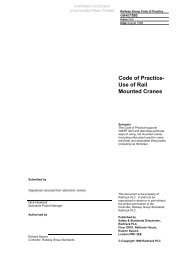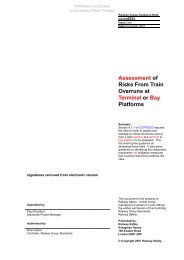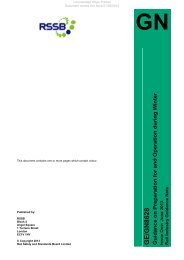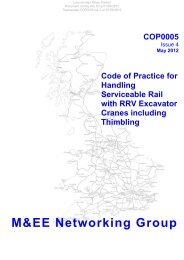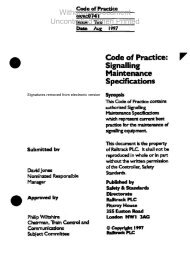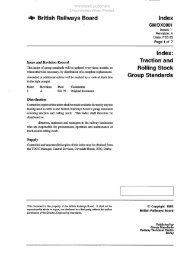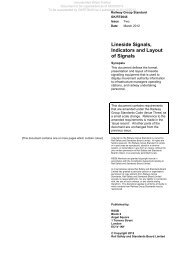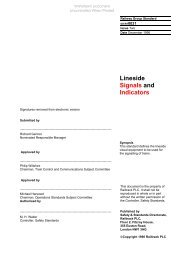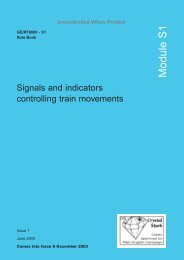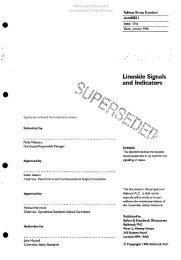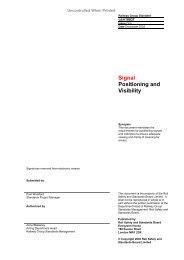General Information on Track Circuits - RGS Online
General Information on Track Circuits - RGS Online
General Information on Track Circuits - RGS Online
You also want an ePaper? Increase the reach of your titles
YUMPU automatically turns print PDFs into web optimized ePapers that Google loves.
<str<strong>on</strong>g>General</str<strong>on</strong>g> <str<strong>on</strong>g>Informati<strong>on</strong></str<strong>on</strong>g> <strong>on</strong> <strong>Track</strong> <strong>Circuits</strong><br />
14 Jointless <strong>Track</strong><br />
<strong>Circuits</strong><br />
Withdrawn Document<br />
Unc<strong>on</strong>trolled When Printed<br />
Railway Group Approved Code of Practice<br />
GK/RC0752<br />
Issue Two<br />
Date December 1998<br />
Page B19 of 25<br />
Insulated rail joints can be expensive both to install and to maintain, especially <strong>on</strong><br />
tracks subjected to high speed, high axle weight traffic or where there is an<br />
intensive service.<br />
The use of audio frequencies permits the physical limits of an individual track<br />
circuit to be defined by tuned short circuits between the rails rather than by<br />
insulati<strong>on</strong> in the rails themselves. C<strong>on</strong>sider two jointless track circuits abutting at<br />
a tuned z<strong>on</strong>e as shown in Figure B15. N<strong>on</strong>–track mounted equipment has been<br />
omitted for clarity.<br />
RAILTRACK B19<br />
Tuned<br />
Z<strong>on</strong>e<br />
Feed F1 Tuning Tuning<br />
Feed F2<br />
Unit F1 Unit F2<br />
Figure B15<br />
The tuned z<strong>on</strong>e comprises a measured length of track with a tuning unit across<br />
the rails at each extremity. The track circuits operate at different audio<br />
frequencies and each tuning unit is designed to its own track frequency, such<br />
that the following criteria are obeyed:<br />
a) C<strong>on</strong>sider frequency F1:<br />
The F2 tuning unit behaves as a short circuit between the rails, due to series<br />
res<strong>on</strong>ance of its inductive and capacitive comp<strong>on</strong>ents.<br />
The F1 tuning unit tunes the two rails (inductive) and the F2 tuning unit short<br />
circuit to parallel res<strong>on</strong>ance, thus presenting a significant impedance to<br />
frequency F1.<br />
b) C<strong>on</strong>sider frequency F2:<br />
The F1 tuning unit behaves as a short circuit between the rails, due to series<br />
res<strong>on</strong>ance of its inductive and capacitive comp<strong>on</strong>ents.<br />
The F2 tuning unit tunes the two rails (inductive) and the F1 tuning unit short<br />
circuit to parallel res<strong>on</strong>ance, thus presenting a significant impedance to<br />
frequency F2.<br />
A wheelset proceeding al<strong>on</strong>g track circuit F1 will shunt the track circuit, but when<br />
it enters the tuned z<strong>on</strong>e its effectiveness will reduce until, having passed tuning<br />
unit F2 (short circuit at frequency F1), it will no l<strong>on</strong>ger shunt track circuit F1.<br />
Similarly, the wheelset would not shunt track circuit F2 as l<strong>on</strong>g as it remained <strong>on</strong><br />
track circuit F1, due to tuning unit F1 presenting a short circuit to frequency F2.<br />
As the wheelset passes F1 tuning unit, it commences to shunt frequency F2,<br />
becoming more effective as it progresses towards the F2 tuning unit and bey<strong>on</strong>d<br />
into F2 track circuit proper.



